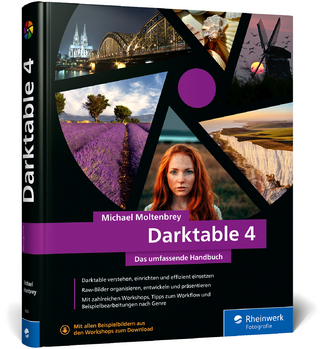
Color Appearance Models
Addison Wesley (Verlag)
978-0-201-63464-8 (ISBN)
- Titel ist leider vergriffen;
keine Neuauflage - Artikel merken
"A clear and authoritative review of an important field in color science." --Dr. R.W.G. Hunt This book is a comprehensive state-of-the-art reference focusing on color appearance models, innovative tools that describe and predict color under a variety of viewing conditions. Written by a leading authority, this book provides any professional or student versed in color science basics with a complete overview of the following color appearance models: *Nayatani et al. *Hunt *RLAB *ATD *LLAB *ZLAB *CIECAM97s For each model, the book examines such aspects as input data, adaptation, opponent-color dimensions, color defining features, predictable phenomena, and the pros and cons of that model. It offers essential background information on human color perception, psychophysics, and the Commission Internationale de l'...clairage (CIE) system of colorimetry that has formed the foundation for color technology since the 1930s. Also addressed are color appearance terminology, color order systems, color appearance phenomena, and an analysis of viewing conditions. The book discusses chromatic adaptation in depth, one of the most important elements of color appearance.The book also includes an overview of device-independent color imaging-the application that represents the greatest technological push for the development of color appearance models.
In all, Color Appearance Models gives you an excellent understanding of the foundation and forefront of color technology, innovative tools now available, and how these recent developments are likely to revolutionize the field. 0201634643B04062001
Mark D. Fairchild is Director of the Munsell Color Science Laboratory and an Associate Professor in the Center for Imaging Science at the Rochester Institute of Technology. The Munsell Color Science Laboratory is the preeminent academic laboratory dedicated to research and education in the science of color. At RIT, Dr. Fairchild performs extensive research in the areas of color appearance modeling, gamut mapping, observer variability in color matching, image reproduction, and computer graphics. 0201634643AB04062001
Preface.
Acknowledgments.
Introduction.
1. Human Color Vision.
Optics of the Eye. The Retina Revisited. Visual Signal Processing. Mechanisms of Color Vision. Spatial and Temporal Properties of Color Vision. Color-vision Deficiencies. Key Features for Color Appearance Modeling.
2. Psychophysics.
Psychophysics Defined. Historical Context. Hierarchy of Scales. Threshold Techniques. Matching Techniques. One-dimensional Scaling. Multidimensional Scaling. Design of Psychophysical Experiments. Importance of Psychophysics in Color Appearance Modeling.
3. Colorimetry.
Basic and Advanced Colorimetry. Why Is Color? Light Sources and Illuminants. Colored Materials. The Human Visual Response. Tristimulus Values and Color-matching Functions. Chromaticity Diagrams. CIE Color Spaces. Color-difference Specification. The Next Step.
4. Color-appearance Terminology.
Importance of Definitions. Color. Hue. Brightness and Lightness. Colorfulness and Chroma. Saturation. Unrelated and Related Colors. Definitions in Equations. Brightness-Colorfulness Versus Lightness-Chroma.
5. Color-order Systems.
Overview and Requirements. The Munsell Book of Color. The Swedish Natural Color System. The Colorcurve System. Other Color-order Systems. Uses of Color-order Systems. Color-naming Systems.
6. Color-appearance Phenomena.
What Are Color-appearance Phenomena? Simultaneous Contrast, Crispening, and Spreading. Bezold-Brücke Hue Shift (Hue Changes with Luminance). Abney Effect (Hue Changes with Colorimetric Purity). Helmholtz-Kohlrausch Effect (Brightness Depends on Luminance and Chromaticity). Hunt Effect (Colorfulness Increases with Luminance). Stevens Effect (Contrast Increases with Luminance). Helson-Judd Effect (Hue of Nonselective Samples). Bartleson-Breneman Equations (Image Contrast Changes with Surround). Discounting-the-Illuminant. Other Context and Structural Effects. Color Constancy?
7. Viewing Conditions.
Configuration of the Viewing Field. Colorimetric Specification of the Viewing Field. Modes of Viewing. Unrelated and Related Colors Revisited.
8. Chromatic Adaptation.
Light, Dark, and Chromatic Adaptation. Physiology. Sensory and Cognitive Mechanisms. Corresponding-colors Data. Models. Computational Color Constancy.
9. Chromatic-adaptation Models.
von Kries Model. Retinex Theory. Nayatani et al. Model. Guth’s Model. Fairchild’s Model.
10. Color Appearance Models.
Definition of Color Appearance Model. Construction of Color Appearance Models. CIELAB. Why Not Use Just CIELAB? What About CIELUV?
11. The Nayatani et al. Model.
Objectives and Approach. Input Data. Adaptation Model. Opponent-color Dimensions. Brightness. Lightness. Hue. Saturation. Chroma. Colorfulness. Inverse Model. Phenomena Predicted. Why Not Use Just the Nayatani Model?
12. The Hunt Model.
Objectives and Approach. Input Data. Adaptation Model. Opponent-color Dimensions. Hue. Saturation. Brightness. Lightness. Chroma. Colorfulness. Inverse Model. Phenomena Predicted. Why Not Use Just the Hunt Model?
13. The RLAB Model.
Objectives and Approach. Input Data. Adaptation Model. Opponent-color Dimensions. Lightness. Hue. Chroma. Saturation. Inverse Model. Phenomena Predicted. Why Not Use Just the RLAB Model?
14. Other Models.
Overview. ATD Model. LLAB Model.
15. Testing Color Appearance Models.
Overview. Qualitative Tests. Corresponding-colors Data. Magnitude-estimation Experiments. Direct Model Tests. CIE Activities. A Pictorial Review of Color Appearance Models.
16. Traditional Colorimetric Applications.
Color Rendering. Color Differences. Indices of Metamerism. A General System of Colorimetry?
17. Device-independent Color Imaging.
The Problem. Levels of Color Reproduction. General Solution. Device Calibration and Characterization. The Need for Color Appearance Models. Definition of Viewing Conditions. Viewing-conditions-independent Color Space. Gamut Mapping. Color Preferences. Inverse Process. Example System. ICC Implementation.
18. The Future.
Will There Be One Color Appearance Model? Other Color Appearance Models. Ongoing Research to Test Models. Ongoing Model Development. What to Do Now.
Appendix A: The CIE Color Appearance Model (1997).
Historical Development, Objectives, and Approach. Bradford-Hunt 96S (Simple) Model. Bradford-Hunt 96C (Comprehensive) Model. The CIE TC1-34 Model, CIECAM97s. The ZLAB Color Appearance Model. Outlook.
References.
Index.
| Erscheint lt. Verlag | 12.2.1998 |
|---|---|
| Verlagsort | Harlow |
| Sprache | englisch |
| Maße | 167 x 242 mm |
| Gewicht | 915 g |
| Themenwelt | Informatik ► Grafik / Design ► Digitale Bildverarbeitung |
| Technik | |
| ISBN-10 | 0-201-63464-3 / 0201634643 |
| ISBN-13 | 978-0-201-63464-8 / 9780201634648 |
| Zustand | Neuware |
| Haben Sie eine Frage zum Produkt? |
aus dem Bereich


